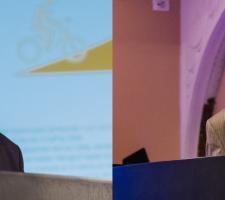
Increasing populations, ever-higher technical and safety requirements, and electric and hybrid vehicles will provide both challenges and opportunities for tolling companies. The annual Study Days event organised by
Opening the conference, Jure Leben, Slovenia’s secretary of state for infrastructure, acknowledged the increasing importance of electronic tolling in financing road building and maintenance, in traffic management, for reducing pollution - and in improving road safety. However, he was very keen on expanding interoperability between tolling systems across Europe and warned that moves towards implementing requirements to ensure interoperability will have financial implications. He singled out the lack of technical standards as a key reason for the slow progress towards interoperability.
Wider challenges
Some of the wider challenges were set out in a video address by European Union transport commissioner Violeta Bulc who emphasised the EU’s third mobility package’s Vision Zero ambitions: zero fatalities by 2050, zero pollution from transport and zero administrative burdens or paper in mobility solutions. In 2017, 25,250 people died on the EU’s roads - and while that is a 2% reduction on the 2016 figure, progress over the past four years has been minimal.
An interim target has been set to halve road fatalities between 2020 and 2030 and Bulc said automated emergency braking (AEB), overridable intelligent speed assistance and detection of pedestrians and cyclists are to be made mandatory in new cars. Dangerous road sections are to be identified and there will be targeted funding for infrastructure improvements in those areas.
She added that autonomous mobility holds tremendous potential to improve accessibility and that the EU is commissioning an in-depth assessment of its socio-economic and ethical impact.
While acknowledging the challenging times ahead, incoming ASECAP president Bill Halkias was upbeat. He said the need for tolling has never been greater as authorities across Europe seek to expand and update their road networks.
In opening the first political session, Halkias focused on the contribution of the private sector to transport infrastructure. He identified the allocation of risk, the ability of the concession model to handle long-term uncertainty (digital evolution, climate change…) and the regulatory asset base and finance model needed to cope with these uncertainties.
Anne Bergenfelt from the European Commission’s Connecting Europe Facility gave a stark message on CO2 and the EU’s efforts to tackle climate change. Since 1990, she said, overall CO2 emissions have been cut by 23% but emissions from road transport have increased by around 20%. By 2030, electric and hybrid cars will account for 30% of new car sales (up from 5%), however this will still only account for around 3% of the energy consumed on Europe’s roads - and less than 2% of the EU’s electricity consumption.
New emissions standards for cars and vans are expected to reduce CO2 emissions by 170 million tonnes per year between 2020 and 2030 – saving around 380 million tonnes of oil. The proportion of road transport CO2 emissions coming from buses is predicted to remain unchanged through to 2050 while that from trucks is expected to rise by around 20%.
However, despite the pledges made in Paris, “The trajectory still falls short,” said Bergenfelt. “And there is a lot more to come.” Part of that effort comes as a road charging proposal for the Eurovignette Directive which will see the introduction of distance-based road user charging for all vehicles by the end of 2025 (2022 for cars). Charges for using the roads will have to reflect ‘external costs’ and mark-ups of up to 25% will be allowed to reflect emissions and/or congestion.
Cross-border enforcement
Jan Szulczyk of the EC’s Road Transport Unit added more detail, saying that the vehicle tax will be removed and there will be a 75% reduction for zero emission vehicles. In addition, the European Parliament is recommending a minimum value for the external costs, does not want charges capped on the amount that can be charged - and advocates the earmarking of revenues for transport.
Updating delegates on the European Electronic Tolling System (EETS), Szulczyk said the proposal now includes some ANPR-based systems and the right to fair remuneration for EETS providers but it will also require transparency of vertically-integrated entities (a tolling company which is also an EETS provider). While data protection requirements will be strengthened, the coverage requirements are likely to be less stringent - although EETS providers will have to be registered from ‘Day 1’ and have a nominated single contact.
Regarding cross-border enforcement within the EU, the proposal is that all types of tolls can be recovered (time and distance, electronic and manual), that the information can be passed to the toll charger and that mutual assistance be given in recovering tolls.
The proposal will also remove the ‘cost neutrality’ requirement for congestion charging and require all vehicles to be charged for the ‘true cost’ of congestion, while defining a congestion trigger level.
Continuing the forward-looking theme, Autoroutes CEO Arnaud Hary focused on the future of daily mobility and the increase in commuting distances, saying many of his company’s motorways are effectively already part of the urban road network. To accommodate the expected increase in commuting, Hary proposes organising the roads for shared mobility with the introduction of high-occupancy vehicle (HOV) lanes (readied for autonomous vehicles) and building direct connections with mass transport stations.
“This can only be done as the contracts have the fixability to promote new mobility schemes around major cities in France,” he said.
The cost of finance
Economist Dejan Makovšek (pictured left, page 45) from the
Although concessions employ user charging and are independent of the government’s general budget, he emphasised the importance of having several bidders for a concession.
This drives competition, efficiency and productivity, he said - but this was not the case if the concessionaire is an arm of the government as there is no efficiency incentive.
“An incoming government does not put a value on the state-owned assets it is inheriting or sign a declaration of the asset value it is passing to the next administration. There is no transparency because governments do not like to make themselves accountable,” he added.
In appointing a private concessionaire, the government is no longer both ‘judge and defendant’. He said a private sector company will ensure the best infrastructure is built at the best possible cost but, counter to some voices in the industry, will not prevent a ‘road to nowhere’ being built. He also added that (in practice) it was not true that private financing alleviates budgetary constraints on a government.
Competition conundrum
“With sea ports and airports, users have a choice of which one to use and this ensures continuing competition,” he said but added that with road transport users have few if any options of which route to take. “This means the only competition in the road concession process is for the awarding of the initial contract.”
Uncertainty impacts the concession process in three ways:
• by deterring some potential bidders
• in terms of costing construction
• unexpected traffic volumes and technology changes
With experience, uncertainties around construction and maintenance should diminish but Makovšek said the high level of failures among construction companies prevents that experience being accumulated and means contractors must build-in a sizeable contingency. “Allocating additional funds for contingency means fewer projects can be built,” he pointed out. The system he preferred was to establish a regulatory asset base (RAB) model which incorporates monitoring by an economic regulator with periodic price reviews and can more easily accommodate changes over the long term such as increases (or otherwise) in traffic volumes.
Which party should shoulder the risk associated with tolling concessions is a continuing debate among ASECAP members and none more so than in Greece where traffic volumes plummeted by 40% as the financial crisis hit.
While operating concessions faired reasonably well (albeit that toll charges could not be increased), Christos Koulouris of Invision Consulting (pictured right) told delegates that the impact on the part-built motorway concessions was devastating.
The rigidity of the the public private partnership (PPP) contracts meant many projects lay dormant for months or years before the terms were ‘reset’ to enable the construction to restart.
Changing economy
Allocating risks during this renegotiation was very difficult. The revised contract should accommodate a changing economy and most included a reduction of the scope of work and an extension of the construction time.
Many of the contractors had to raise additional capital and bank loans were replaced by the state taking a share of the toll revenue.
In some cases the concession duration was extended and claw-backs were inserted to recover the additional state contributions. That these measures worked is evident from Greece now having some 2,000km of motorways.
The example set by Greece’s tolling sector in adapting to surviving extreme turbulence in the country’s economy illustrates that contractual flexibility and risk sharing are necessary in long-term concessions.
These aspects and more are sure to be examined again during ASECAP’s 2019 Study Days which will take place in Costa Navarino, Greece, in May 2019.
Importance of safety
Antonio Avenoso from the
Also on the proposal list for mandatory fitment on all new vehicles is a standard interface to fit (if required) alcohol interlock, drowsiness/attention/distraction detection systems, a reversing camera and an emergency stop signal. Cars and vans would also require lane-keeping assist, an enlarged head impact zone (for cyclists and pedestrians), improved seatbelts, pole side impact protection and a data recorder. New vans, trucks and buses will have to be fitted with tyre pressure monitoring systems and design changes will be required for larger vehicles to provide drivers with direct sight of pedestrians and cyclists. This must be backed up with vulnerable road user (VRU) detection systems.
European proposals
Attila Eordogh from
After 2019, road authorities will be required to address all ‘safe system’ areas (governance, enabling and funding, roads, vehicles, road use, emergency response) plus any emerging challenges. There will also be a set of general requirements for road markings and road signs to facilitate the roll-out of co-operative, connected and automated mobility systems. Particular measures will extend the scope to cover all motorways and primary roads and EU-funded roads outside urban areas. Network-wide road assessments will be required with systematic and proactive risk mapping to assess the inherent safety of roads across the EU. The transparency of the follow-up of infrastructure safety management procedures will be mandated. It will also be mandatory to take VRUs into account in all road safety management procedures.















